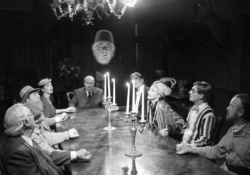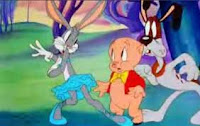This week, two attempts to translate cult favorites to the language of film, with gibberish the results.
When do you first get the feeling that Land of the Lost is in trouble? Not counting when you first saw the trailer. When? Immediately.
In the movie's first post-title scene, crackpot scientist Rick Marshall (Will Ferrell) is flogging his new book on "The Today Show" and his interview with Matt Lauer, playing himself, isn't going well. Lauer gets the movie's first laugh and I wondered if Ferrell and director Brad Silberling really meant for Matt Lauer to set the pace.
Dr. Marshall believes that movement between dimensions and alternate universes is possible, but he doesn't attempt a field test of his tachyon gizmo until encouraged by Holly, a hot young science student from England (Anna Friel). They experience "the greatest earthquake the world has ever known" and, along with a redneck doofus named Will (Danny McBride) wind up in a place where anything dreamed up by sitcom writers can happen.
After flopping down on a patch of lost-land desert containing a Viking ship and what could be Amelia Earhart's plane, they meet Cha-Ka, a Sleestak, sort of a 2001 australopithecine reject (Jorma Taccone). From there, the movie is essentially a series of sketches and concepts, most of which don't work very well stretched out over 93 minutes.
So what do we get? Lots of aimless running and screaming—the farce's traditional demand for "louder, faster, funnier." Two of out three, anyone? There are some CGI dinosaurs. Several gags based on bodily excretions, especially numbers one and two. Some of the throwaway gags worked for me. As the tachyon gizmo first hums to life we see Dr. Marshall looking down at it, his face lit by a soft blue light. "It's beautiful," he gasps in a moment that perfectly parodies Paul Freeman's Dr. Belloq in Raiders of the Lost Ark just before his head melts.
If only TV writers Chris Henchy and Dennis McNicholas could have come up with more stuff like that, Ferrell wouldn't have to fall back on re-cycling his standard movie persona. Yes, earlier movie comedians have mined one character for all s/he was worth, but audiences saw them only once or twice a year. With basic cable, On Demand and DVD, we can see Will Ferrell, or any movie star, so often it's easy for them to become over-exposed.
Matt Lauer ends the movie with another solid laugh. Who knew? Maybe Land of the Lost isn't really a Will Ferrell picture at all. Maybe it's a Matt Lauer movie and Ferrell just hogs most of it. Maybe theyshould have cut out all that unfunny Ferrell stuff for the DVD. That would leave us with a five-minute movie full of LOL material instead of an intermittently amusing 93-minute one. Sounds good to me.
And now for something almost exactly the same, the movie equivalent of The Hindenburg crashing into the Titanic, the non plus ultra of big budget bad movies, the one, the only . . .
Howard the Duck.
Re-visiting older films you once panned is good for the critic's humility. You frequently find that The Movie in Question isn't as bad as you thought it was. Maybe that's because you've seen so many even stinkier floppiles since the initial viewing. Maybe you're just mellowing. Maybe senility is taking over.
Well, I'm here to announce that I am not mellowing and senility is not yet my dominant mental condition. Howard the Duck is just as bad as it ever was. Time has not blossomed nor custom improved its unique blend of over-production and cheap-jack special effects, nor its lousy acting, insulting script, and hapless direction. If you were watching "Jeopardy" and the category was "Rotten Movies," the correct response to every clue would be Howard the Duck.
Adapted from the super comic book created by Steve Gerber, this mess of a movie was produced by George Lucas, who apparently learned nothing from the derision he received over the little people in teddy bear costumes in Return of the Jedi in 1983 and allowed Ed Gale, whose subsequent career included stunt doubling Chucky in the Child's Play series, to don a risibly unconvincing duck suit. Howard, who is transported against his will from the Duck Planet to Earth, is supposed to be a master of Quack Fu but can barely waddle around.
Arriving on Earth, he is abused, laughed at and smacked around—no one has sense enough to grab him and rush him to the nearest Ripley's Believe It or Not Museum. Finally, he comes to the rescue of second rate rock singer Beverly Switzler (Lea Thompson) who takes him home with her and, maybe, falls in love with him. Together, and with the help of lab tech Phil Blumburtt (a hideously overacting Tim Robbins) they save the world from an invasion of Dark Lords of the Universe, led by a possessed Dr. Jenning (Jeffrey Jones).
The opening getting-to-know-you segment lasts way too long, the Dark Lords section is played too straight, and the film's last two reels are nothing but explosions, screaming, and the kind of stop motion animation that was amazing in King Kong but was sadly antiquated by 1986. The picture was directed by Lucas' buddy Willard Huyck and written by Huyck and Gloria Katz. Why the hell didn't they get Steve Gerber to at least chip in? The man, who died in 2008, was a terrific comic book satirist. Maybe Lucas and Co. were just set on turning out a family comedy instead of the R rated burlesque of comics, movies and life in general the picture would have had to be in order to duplicate the real Howard. The missed opportunity is as painful as a kidney stone the size of a duck egg.
But one good thing came of it all. The film's box office failure was so severe it forced Lucas to sell the Lucasfilm animation department in order to keep the rest of the empire afloat. He sold it to Steve Jobs and it became Pixar.
Howard the Duck was such a massive flop it must be seen to be believed, so take a look next time it shows up on cable—but for the sake of your soul, don't buy it. People have gone to hell for a lot less. Poor Howard deserved better than this. You will believe a male duck can lay an egg.









